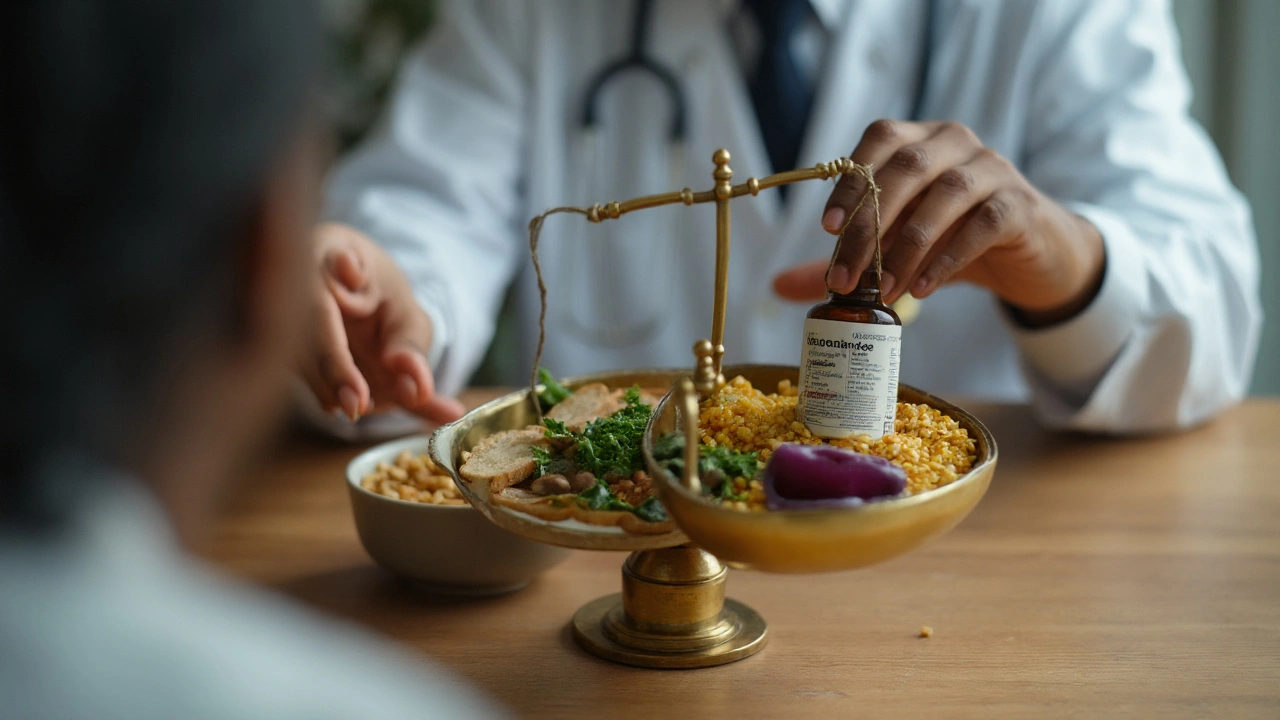You want the honest answer: What does manganese actually do, do you need to take it, and how do you avoid overdoing it? This guide cuts through the hype. You’ll see what manganese supports inside your body, who might consider a supplement, exact daily targets, the best food sources, and safety rules that don’t budge.
- TL;DR
- Manganese helps your mitochondria fight oxidative stress (via MnSOD), supports collagen and bone formation, and assists in metabolising carbs, amino acids, and cholesterol.
- Adults typically need about 1.8-2.3 mg/day (Adequate Intake, NIH Office of Dietary Supplements). Upper Level is 11 mg/day for adults-don’t exceed without medical advice.
- Food first: whole grains, nuts, seeds, legumes, leafy greens, and tea usually cover needs. Deficiency is rare.
- Consider a small-dose supplement only if your intake is low or you have a specific medical reason. Keep doses modest (often 1-2 mg/day) and avoid stacking with high-dose iron/calcium at the same time.
- Be cautious if you have liver/biliary disease or take antibiotics (quinolones/tetracyclines)-interactions and toxicity risks are real.
What Manganese Does: The Real-World Benefits (Not the Hype)
Manganese is a trace mineral. Your body needs only milligrams, but it uses them in high-stakes jobs.
- Antioxidant defense inside mitochondria: Manganese is the cofactor for manganese superoxide dismutase (MnSOD), the enzyme that neutralises superoxide radicals where energy is made. This is a core, non-negotiable role backed by decades of biochemistry research and summarised by the NIH Office of Dietary Supplements and the Linus Pauling Institute.
- Connective tissue and bone: Enzymes that build cartilage and collagen (glycosyltransferases) need manganese. That’s why it shows up when we talk about healthy tendons, ligaments, and bone matrix.
- Metabolism: It helps enzymes that process carbohydrates, amino acids, and cholesterol. Think of it as a tiny tool that lets bigger proteins do their jobs.
- Brain function: Manganese is involved in neurotransmitter pathways (for example, via glutamine synthetase). Too little isn’t good for the brain; too much is also risky. Balance matters.
What manganese does not do well on its own: fix joint pain, boost energy overnight, or “detox” your body. Research on manganese as a solo supplement for osteoarthritis or blood sugar is inconsistent or weak. Some commercial blends for joints include manganese, but the benefit usually can’t be pinned on manganese alone.
Bottom line: your body needs manganese, but not in large amounts. The safest win is meeting your needs through food and considering supplements only when there’s a clear reason.
How Much You Need-and When to Consider Supplementing
Daily targets are expressed as Adequate Intakes (AI) because there isn’t enough data to set precise RDAs. The following figures are from the NIH Office of Dietary Supplements and the National Academies’ Dietary Reference Intakes.
- Adult women: ~1.8 mg/day
- Adult men: ~2.3 mg/day
- Pregnancy: ~2.0 mg/day
- Lactation: ~2.6 mg/day
- Upper Level (UL) adults: 11 mg/day (includes food, water, and supplements)
Note: Different authorities vary slightly. Many countries reference similar ranges. The guiding principle stays the same-small daily amounts, don’t exceed the UL, and food first.
Do you actually need a manganese supplement? Most people don’t. Consider one if:
- Your diet is low in whole plant foods (few whole grains, nuts, seeds, legumes, leafy greens).
- You’re on a medically restricted diet or have malabsorption issues (e.g., long-term TPN, certain GI disorders), under a clinician’s care.
- You’re pregnant or lactating and your overall diet quality is low. Still, start with food and a standard prenatal; ask your midwife or GP before adding extra manganese.
- You have confirmed low intake from a dietitian’s assessment. Blood manganese tests are not very reliable for status; clinical context matters.
Who should be cautious or avoid extra manganese unless instructed by a clinician:
- People with liver or biliary disease: manganese is excreted via bile; impaired excretion increases toxicity risk.
- Those with high occupational exposure (e.g., welding fumes): avoid additional supplement exposure.
- Anyone already taking a multivitamin/mineral with manganese-stacking products can push you toward the UL without noticing.
Practical dosing rules of thumb (if a clinician suggests supplementing):
- Keep it modest: 1-2 mg/day is common. Avoid high doses unless medically supervised.
- Timing: don’t take it with large amounts of iron, calcium, magnesium, or phosphorus-they can reduce manganese absorption. If you need both, separate by at least 2 hours.
- Form: Mn gluconate, sulfate, and chelates (e.g., bisglycinate) are all used. Differences in absorption are less important than sticking to an appropriate dose and timing.
- Side effects: GI upset is possible. Neurological issues arise with chronic excessive intake-not something to test.
Food-First Game Plan: Easy Wins and a Handy Table
Plants are your best source. A normal day of oats, a handful of nuts, some legumes, leafy greens, and tea can easily reach the target. If you’re in New Zealand, think oats for breakfast, wholegrain toast at lunch, a bean-and-veggie dinner, and a cuppa-done.
Typical manganese amounts vary by soil and processing. The table below uses rounded, commonly cited values from nutrient databases and the NIH Office of Dietary Supplements. Use it as a ballpark guide, not a lab report.
| Food | Serving | Approx. Manganese (mg) | Notes |
|---|---|---|---|
| Oatmeal, cooked | 1 cup | 1.0-2.0 | Varies by brand and fortification. |
| Brown rice, cooked | 1 cup | 1.0-1.8 | Whole grains retain more manganese than white rice. |
| Chickpeas (garbanzo), cooked | 1/2 cup | 0.6-0.9 | Great in salads and curries. |
| Lentils, cooked | 1/2 cup | 0.3-0.5 | Pairs well with rice for a mineral-friendly meal. |
| Spinach, cooked | 1/2 cup | 0.4-0.6 | Leafy greens contribute small but steady amounts. |
| Hazelnuts | 28 g (1 oz) | 0.6-0.8 | Nuts and seeds are concentrated sources. |
| Pecans | 28 g (1 oz) | 1.0-1.3 | One small handful goes a long way. |
| Pineapple, fresh | 1 cup | 1.3-1.6 | One of the few fruits high in manganese. |
| Black tea, brewed | 1 cup | 0.3-0.6 | Two to three cups add up quickly. |
| Whole-wheat bread | 1 slice | 0.2-0.3 | Small amounts that stack across the day. |
| Mussels, cooked | 85 g (3 oz) | 2.0-6.0 | Wide range; shellfish can be manganese-rich. |
Simple daily template to hit your target without counting:
- Breakfast: 1 cup cooked oats + berries or a slice of wholegrain toast.
- Snack: Small handful of pecans or hazelnuts.
- Lunch: Leafy greens + chickpea salad or a lentil soup.
- Dinner: Brown rice bowl with veggies and tofu/beans.
- Drinks: 1-2 mugs of tea if you enjoy it.
That line-up comfortably covers 1.8-2.3 mg for most adults.

Step-by-Step: Safe Supplementing and Smart Pairing
If you and your clinician decide a supplement makes sense, here’s how to do it safely.
- Audit your current stack.
- Check labels on multivitamins, “hair/skin/nails” formulas, and joint blends. Add up total manganese per day.
- If you’re already getting ~1-2 mg from a multi, you probably don’t need more.
- Pick a modest dose.
- Standard standalone doses: 1-2 mg/day. Avoid high-dose products unless prescribed.
- Choose a reputable brand that batch-tests for heavy metals. Trace minerals can be contaminated if poorly sourced.
- Time it right.
- Separate from high-dose iron, calcium, magnesium, or phosphorus by at least 2 hours to reduce competition.
- Take with food if you get nausea on an empty stomach.
- Watch for interactions.
- Antibiotics: quinolones (e.g., ciprofloxacin) and tetracyclines can bind minerals; take manganese several hours apart.
- Antacids/laxatives containing aluminum, calcium, or magnesium can interfere with manganese absorption and vice versa.
- Discuss meds with your GP or pharmacist to set safe spacing.
- Check in after 6-8 weeks.
- Reassess diet quality; aim to shift back to food sources.
- If no clear benefit or reason remains, taper off.
Safety flags to take seriously, backed by the NIH ODS and toxicology reports:
- Don’t exceed 11 mg/day from all sources unless supervised.
- Long-term excess can cause neurological problems (manganism), especially with impaired liver function or high occupational exposure.
- Kids are more sensitive. Don’t give manganese supplements to children without professional guidance.
- If you’re on bore water or a private supply, and suspect metallic taste or staining, check your water quality report; water can contribute meaningful manganese in some regions.
Cheat Sheets, Pitfalls, and Quick Decision Aids
Quick checklist: Do you likely need a supplement?
- I eat whole grains, nuts/seeds, legumes, leafy greens, and sometimes drink tea → Probably not.
- My diet is low in plant foods and I avoid whole grains → Maybe a short-term low-dose supplement while I improve diet.
- I have malabsorption or I’m on medically supervised nutrition → Ask your specialist; doses are individual.
- I already take a multi with 1-2 mg → Don’t stack more without a reason.
Common pitfalls to avoid:
- Confusing manganese with magnesium-different minerals, different roles.
- Taking manganese at the same time as iron or calcium and thinking it’s “not working.” Space them.
- Assuming “more antioxidants” is better. Your mitochondria need balance, not mega-doses.
- Relying on hair mineral tests for diagnosis. They’re unreliable for manganese status.
Rules of thumb that hold up:
- Food-first usually hits the AI without effort.
- Keep supplemental manganese ≤2 mg/day unless advised.
- Check the total from all products; hidden manganese shows up in multis and joint formulas.
- If you have liver/bile duct issues, prioritise medical guidance before any extra manganese.
Mini‑FAQ
Is manganese deficiency common?
No. True deficiency is rare in healthy adults. It shows up in severe malnutrition or specific medical scenarios. Symptoms reported in deficiency research include poor bone growth, skin rashes, altered glucose or lipid markers, and mood changes-but again, this is uncommon in free‑living adults eating varied diets.
Can manganese supplements help joints?
Evidence is mixed. Some joint formulas include manganese with glucosamine/chondroitin, but benefits can’t be pinned on manganese alone. If joint pain is your main issue, talk to your clinician about therapies with stronger support.
Is manganese good for blood sugar?
Manganese-dependent enzymes play roles in metabolism, but human trials using manganese to improve glycaemic control haven’t delivered clear wins. Don’t use manganese as a diabetes treatment.
What about pregnancy?
Pregnant adults need about 2.0 mg/day (AI). Most prenatal vitamins and a balanced diet cover this. Avoid stacking extra manganese unless your midwife or GP recommends it.
How do I test my manganese status?
There’s no perfect, widely agreed test for body manganese. Blood levels don’t always reflect tissue levels, and hair testing is unreliable. Clinicians look at diet patterns, medical history, and sometimes specialised tests when there’s a strong reason.
Can tea give me “too much” manganese?
Tea contributes meaningful manganese, but typical intakes in healthy adults aren’t linked to toxicity. Problems arise with very high total intake, impaired excretion, or occupational exposure. If you drink lots of strong tea and also supplement, tally your total and stay under the UL.
What interactions should I know?
Mineral-antibiotic interactions are the big one: separate manganese from quinolones or tetracyclines by several hours. Also space it from high-dose iron and calcium to improve absorption. Ask your pharmacist for timing if you’re on multiple meds.
Which form is best-gluconate, sulfate, or chelate?
All can work. Quality, dose, and timing matter more than the exact form. Choose a product from a reputable brand with third‑party testing.

Next Steps and Troubleshooting
If you’re unsure where to start, use this plan:
- Do a 3‑day diet snapshot (two weekdays + one weekend day). Count how many times whole grains, nuts/seeds, legumes, leafy greens, and tea show up.
- Aim for at least 2-3 of these manganese‑rich food categories daily. Re-check after a week-chances are you’ll be on target without a pill.
- If you still suspect a gap, consider a low-dose standalone (1-2 mg) or ensure your multivitamin includes a similar amount. Avoid duplication.
- Check interactions and timing with your meds. Space from iron/calcium and certain antibiotics.
- If you have liver disease, are pregnant, or have complex health conditions, involve your clinician before adding manganese.
Scenarios:
- Plant‑based eater: You likely get enough if you include oats or brown rice, beans/lentils, nuts/seeds, and greens. No supplement needed for most.
- Low‑carb or grain‑free: Lean on nuts, seeds, leafy greens, legumes (if they fit your plan), and tea. Consider a 1 mg supplement short‑term if your intake is sparse.
- Heavy tea drinker: You probably don’t need extra manganese. If you also take a multi, skip an additional standalone.
- On quinolone/tetracycline antibiotics: If you must take manganese, separate by several hours. Ask your pharmacist for exact timing.
- Liver/biliary issues: Avoid supplemental manganese unless your specialist says otherwise.
Credibility corner (authorities you can look up): NIH Office of Dietary Supplements (Manganese Fact Sheet), National Academies of Sciences (Dietary Reference Intakes for Trace Elements), Linus Pauling Institute Micronutrient Information Center, and toxicology reviews cited by public health agencies. These bodies summarise the evidence on needs, roles, and safety limits in plain numbers you can trust.
The takeaway: meet your need through everyday food, supplement only with a clear reason, keep doses small, and respect the 11 mg/day ceiling. That’s how you get manganese’s best without the risks.



Manganese isn’t some magic bullet-it’s the quiet plumber in your mitochondria fixing leaks no one sees. You don’t need a supplement unless your diet’s been reduced to kale chips and protein powder. Real food? Oats, pecans, tea. Done. The hype machines sell you ‘antioxidant power’ so they can sell you a $30 capsule with 5mg of manganese and a side of aluminum dust. Don’t be that person.
And for god’s sake, stop stacking it with iron. You’re not a biochemist. You’re just hungry for a quick fix. Your body knows what it’s doing. Let it.
Also, if you’re drinking 8 cups of black tea a day and then taking a ‘bone support’ pill? Congrats. You’re basically welding your own brain. Slow down.
Food first. Always. Even if it’s boring. Even if it doesn’t glow under UV light.
TL;DR: Stop overthinking trace minerals. Eat real food. Sleep. Move. That’s your real supplement.
And if you’re reading this on your phone while eating a protein bar? Put it down. Go make a sandwich with whole grain. Now.
Okay but have you considered that manganese is secretly controlling your dreams? I mean, it’s in your brain, right? And your brain’s basically a quantum computer powered by trace minerals. I’ve been tracking my sleep since I started taking 5mg-now I remember every dream, even the ones where I’m flying over a lake of soy sauce. Coincidence? I think not.
Also, I read a paper once that linked manganese to soul alignment. Not scientifically, but like… energetically. My aura’s been brighter since I started. I’m not saying you should take it, but… have you checked your chakras lately?
And what about the government? Why do they never talk about manganese in the water? Did you know some towns have levels 3x higher than the UL? Are they trying to make us docile? Or… smarter?
I’m not paranoid. I’m just… observant.
This is one of the clearest guides I’ve read on manganese. Thank you.
I’m a nurse and I see so many people self-prescribing supplements because they read a blog that said ‘manganese cures arthritis.’ It’s heartbreaking. You’re right-food first. A handful of almonds, a bowl of oatmeal, a cup of tea. That’s it.
If someone’s on antibiotics or has liver issues, they need to talk to their doctor, not Reddit. This post says it all without the noise.
Just… please, if you’re reading this and thinking ‘I need more,’ pause. Look at your plate. You’re probably already getting enough.
And if you’re not? Start with lentils. They’re cheap, delicious, and don’t come in a bottle.
Okay but why does this post feel like a textbook chapter with a LinkedIn bio? Like, I get it, manganese is important. But did we really need 17 paragraphs on tea? Who even drinks that much tea?
Also, the table? Cute. But I’m not measuring my pecan intake to the tenth of a milligram. I just eat nuts. I drink coffee. I sleep. I live.
And the ‘don’t take with iron’ thing? Bro, I take my multivitamin with breakfast and my iron pill with lunch. I’m not a chemist. I’m just trying to not die.
TL;DR: This is overengineered. Eat food. Don’t panic. You’re fine.
Also, who wrote this? It reads like a NIH intern trying to impress their boss with 10 citations.
It’s fascinating how we treat trace minerals like they’re either magic or poison. Manganese is neither. It’s just… there. A quiet player in the orchestra of metabolism. We don’t need to worship it or fear it. We just need to notice it.
What’s interesting is how our modern diets have made us both deficient in some things and overexposed to others-without ever feeling the balance. We’ve lost the rhythm of eating whole, unprocessed things. That’s the real issue, isn’t it?
Supplements aren’t the solution. They’re a symptom.
I wonder if we’d even be asking these questions if we ate like our grandparents did. Not because they were ‘healthier,’ but because they didn’t have 500 options in the supplement aisle.
Maybe the answer isn’t more data. Maybe it’s less noise.
Tea is my main source. Two cups a day. Oats for breakfast. Almonds as snack. Done.
No supplement. No stress.
This is how it should be.
Simple.
Real.
Not complicated.
Thank you for this. No fluff. Just facts.
From India, where we eat dal and rice and chai every day. We’ve been doing this for centuries.
You don’t need a pill to be healthy.
You just need food.
Let’s talk about the real agenda here. The NIH? The Linus Pauling Institute? All funded by Big Food and Big Pharma. Manganese is being downplayed because they want you to buy expensive chelated forms that cost $25 a bottle. Meanwhile, the real toxicity is hidden in the food supply-glyphosate binds manganese in soil, making crops deficient, so they pump it into processed foods as ‘fortification.’
And what about the fluoride in your water? It competes with manganese. That’s why you’re tired. That’s why you have brain fog.
They don’t want you to know that manganese deficiency correlates with autism rates. Or that it’s a biomarker for early neurodegeneration.
They’re hiding it. Because if you knew how critical this mineral is, you’d stop buying their supplements and start demanding clean soil, clean water, and real food.
This guide? It’s a distraction. A placebo for the woke consumer.
Wake up. The system is rigged. And manganese is the key they don’t want you to hold.